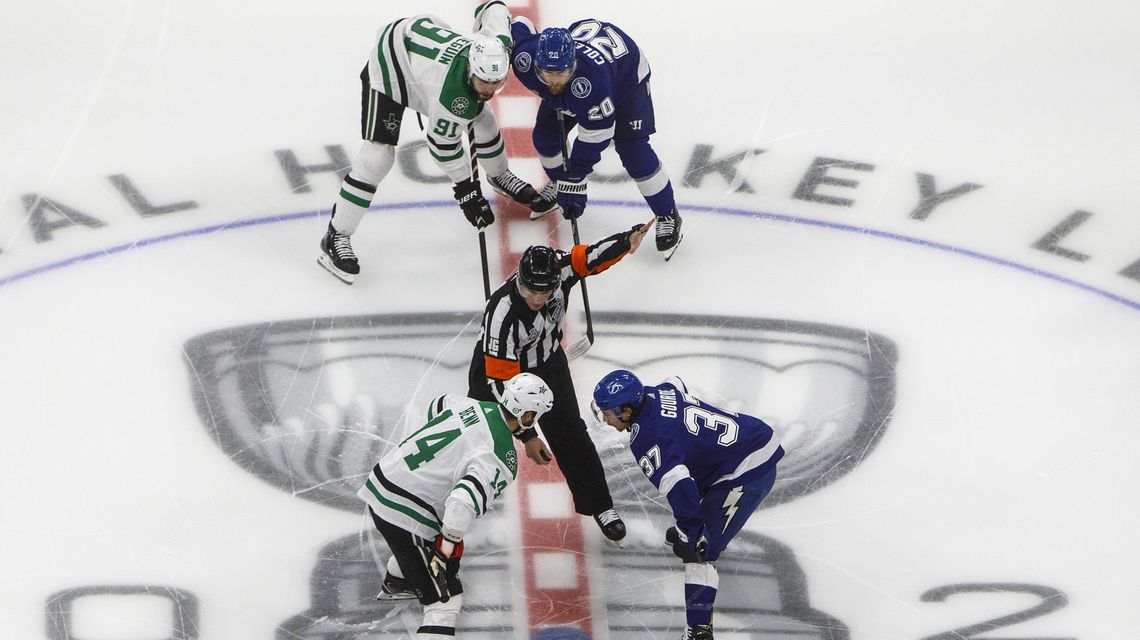
Stanley Cup Faceoff: Stars, Lightning showing value of draws
EDMONTON, Alberta (AP) — When Ron Francis knew something was working on faceoffs, he would experiment and not use his best moves right away.
That was usually during the regular season. In the playoffs and in the Stanley Cup Final, the Hall of Fame center knows players can’t afford not to go all out to win them.
“They’ve become more and more key as the games become more and more important,” said Francis, now the general manager of the NHL’s expansion Seattle Kraken. “In its simplest form, if you win the puck, you have possession. You start with possession and then you’re automatically on offense. If you lose the draw, now you’re on defense and you’ve got to go hunt to get it back and expend energy to kind of get it.”
Faceoffs late in tight games are always important, particularly those in the zone of a team clinging to a lead. While overall faceoff performance has been debated in recent years with more information available and different ways to analyze its importance, this final is showing the value of draws because of how the Dallas Stars and Tampa Bay Lightning prefer to play.
Dallas lost 64% of faceoffs in the first period of Game 2 and fell behind 3-0. The way Tampa Bay can dominate when it has the puck puts a spotlight on the faceoff circle in this series.
“It’s hard enough to get the puck, so it’s a set situation: one of the few times you can somewhat control what’s going to happen, and faceoffs are it,” Lightning coach Jon Cooper said. “Often times you can see a team, if they’ve got a huge advantage in the faceoff circle, especially on special teams, it’s an advantage.”
Keith Jones thinks it’s a bigger advantage than ever before because of faceoff rule changes designed to increase offense. Gradually since 2005, the NHL has made it so all power plays start in the offensive zone; the team that ices the puck can’t change its players; the player on defense has to put his stick down first; and any puck shot out of play on offense stays in the attacking end.
Jones, a former NHL winger and now an NBC Sports analyst, pointed to multiple overtime goals in the Islanders-Flyers series that resulted from an icing mistake and a lost defensive-zone faceoff. Francis also noted the Stars’ power-play goal in Game 2 that came five seconds after a faceoff win.
“Certainly the four dots in the end zones are the most critical because they can lead to goals,” said Francis, a top faceoff artist as a player. “It’s a part of the game that maybe a lot of people don’t talk about, but I think it’s extremely important and it leads to possession, which leads to offense.”
That’s why Stars interim coach Rick Bowness harped on the faceoff discrepancy early in the game Monday night. His team lost 13 of 20 even-strength faceoffs, then took penalties and turned the puck over more as a result of not being in control. The Lightning scored twice on the power play and once at 5-on-5.
“When you’re losing the faceoffs like we did in the first period, you’re chasing the game,” Bowness said. “To beat this team, we need to be better in the faceoff circle and we need to manage the puck a lot better. If we do that, then we’re going to take less penalties.”
Because Dallas is the most penalized team in the playoffs, faceoffs are a nice starting point to cutting down on the lack of discipline. It becomes a mix of video study and practice, taking draw after draw during a morning skate.
“Every single time when you win the faceoffs, you are in charge of the game and you are creating the plays,” Stars defenseman Andrej Sekera said. “We’ve just got to make sure that we have a plan after every faceoff and try to get the puck out from our zone up and go in their zone and play some hockey there.”
Easier said than done, especially without injured center Radek Faksa, who has won 128 of his 266 attempts for Dallas but brings added value no matter the result.
“I don’t think we can underestimate how important Faksa’s been to that team for a long time, and that’s part of his game,” Jones said. “Probably not something that jumps off the page, but he’s an important guy not just in the faceoff circle but then sorting things out after a faceoff win or a loss.”
Possibly missing forward Blake Comeau, too, Dallas might have to find a way to better compensate if faceoffs again tilt heavily in the Lightning’s favor. Francis as an assistant coach would chart faceoffs live on the bench to know which matchups were good and bad for his team.
“To me, it was always kind of a chess match sort of within the game with me and the other centermen,” Francis said. “If you’re losing multiple draws against (someone), you can’t keep sticking with the same thing. You’ve got to try and change something up or figure out what’s kind of going wrong for you.”
Figuring out what’s going wrong on faceoffs could also help players on the Stars — and Lightning, who Cooper said have been “hot and cold in that department” — get their all-around game in order. Jones looks at how someone like Sidney Crosby shored up his faceoff prowess and believes it there is a clear boost from winning a visible, one-on-one competition.
“How it must feel psychologically to a centerman who’s struggling on the draws and knows that he’s letting his team down — he knows his wingers have to go out there and block a big blast from the point,” he said. “Some of those things are critically important to a player’s psyche, not just the importance of possessing the puck but also the importance of winning draws and building confidence.”
___
More AP NHL: https://apnews.com/NHL and https://twitter.com/AP_Sports








